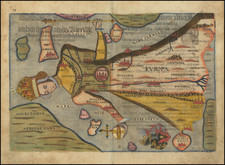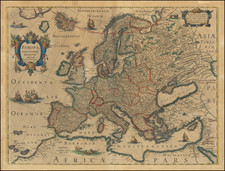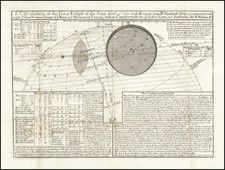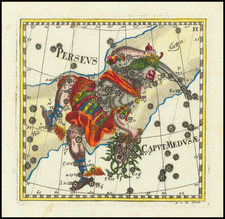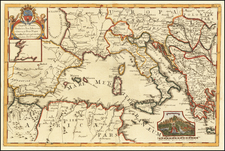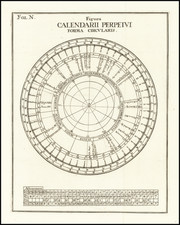Possibly a Unique Example of Female Co-operative Cartography -- Collaboration Between An Important Female Astronomer and Two Female Engravers
This map, created by the remarkable Nicole-Reine Lepaute in 1762, provides a detailed illustration of the predicted path of the solar eclipse across Europe and part of North Africa on April 1, 1764. The map was engraved by Madame Lattre and Madame Elisabeth Clare Tardieu.
This rare and unique map represents the solar eclipse of April 1, 1764, a collaborative effort by three remarkable women of the 18th century. It showcases the path of the eclipse across Europe and a portion of North Africa, delineated by an overprinting in black ink from a second plate, distinct against the sepia tone of the primary image. The subtle yet discernible impressions of the two plates are visible just outside the neat line bordering the map, revealing the intricate process of its creation.
The central shaded path marks the annular eclipse, where observers would see the Sun as a bright ring around the Moon, while the surrounding lines denote the regions that would witness a partial eclipse. Peter Barber notes an interesting discrepancy in the map's accuracy: the central path is depicted approximately 50 miles too far west, which led to Paris unexpectedly experiencing a full annular eclipse. Time indicators in Roman numerals trace the eclipse’s journey, from its start at 10 am at Cape St. Vincent to its conclusion at 11:30 am on Lapland’s northern coast. A diagram on the right of the map elegantly illustrates the two types of eclipses, with annotations on the locations where each could be observed.
The map's two-color printing is a rare feature for its time and enhances its decorative quality, along with the beautifully engraved cartouches by Madame Elisabeth Clare Tardieu. This stylistic approach renders the map not only a scientific tool but also an art piece.
Nicole-Reine le Paute, an instrumental figure in the creation of the map, was an accomplished French astronomer and mathematician. Known for her collaboration with Jerome Lalande and her significant contributions to astronomy—including the prediction of the 1764 eclipse—her legacy is solidified with an asteroid and a lunar crater named in her honor.
The map was initially believed by modern scholars to have been produced in 1764, retrospectively depicting the eclipse. However, it was actually published in 1762, accompanied by a pamphlet explaining its significance and was presented to the King in August of that year.
Madame Lattre, whose role in the map’s creation is highlighted alongside the work, was associated with her husband Jean Lattre, a royal engraver and map publisher. Madame Tardieu, whose contribution to the map's elegant cartouches is noteworthy, was likely part of the renowned Tardieu family of engravers.
Rarity
The map is very rare.
OCLC notes examples at the LIbrary of Congress, New York Public Library, Bibliotheque National de France and the British Library.
Peter Barber, The Map Book, p. 220.
Nicole-Reine Lepaute (née Étable de la Brière) was born on January 5, 1723, in the Burgundy region of France. She was a French astronomer and mathematician known for her significant contributions to astronomy during the 18th century, a time when female participation in scientific disciplines was far from commonplace. Her innate curiosity, rigorous intellect, and diligent application of her skills to the advancement of astronomical knowledge make her a fascinating figure in the history of science.
Little is known about Lepaute's early life and education. It is believed that she was mostly self-taught. However, she demonstrated a profound interest in scientific pursuits from a young age. Her marriage to Jean-André Lepaute, a prominent clockmaker to the King, in 1749, became a turning point in her life. Together, they constructed an astronomical clock, which brought her to the attention of the notable astronomer, Jérôme Lalande in 1753. This connection would shape her career and contribute significantly to her subsequent accomplishments.
Lepaute and Lalande formed a partnership that lasted for many years. Their first major joint endeavor was calculating the trajectory of Halley's Comet, which was due to pass near Earth in 1759. Using Newtonian mechanics and observational data, they accurately predicted the comet's perihelion (the point in its orbit closest to the sun). This successful prediction cemented Lepaute's reputation as a skilled and accomplished astronomer.
Lepaute went on to predict the solar eclipse of April 1, 1764, a feat that further demonstrated her exceptional ability to calculate and predict celestial phenomena. Notably, she also calculated the timing of the 1761 transit of Venus.
Between 1760 and 1774, Lepaute produced ephemerides for the Connaissance des Temps, an almanac published by the French Academy of Sciences. This publication was a crucial resource for astronomers and navigators, providing information on the positions of celestial objects at different times. Her work required complex mathematical calculations and detailed knowledge of the movements of celestial bodies.
Lepaute's contributions to astronomy were recognized by her contemporaries. Lalande lauded her as "the most distinguished female astronomer France had produced". Her death in 1788 was mourned by the scientific community.
Posthumously, Lepaute's contributions to astronomy have been further recognized. The lunar crater 'Lepaute' and the asteroid '4122 Lepaute' are named in her honor, ensuring her name continues to be associated with the field she so passionately pursued.









